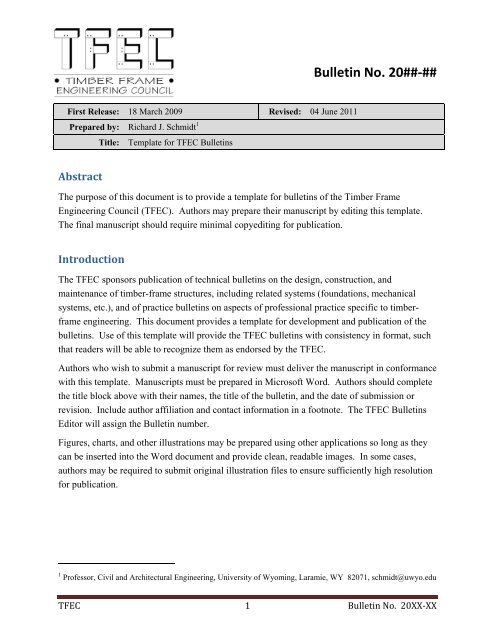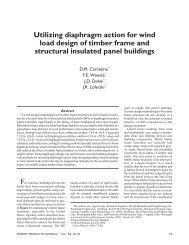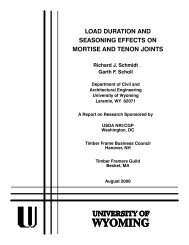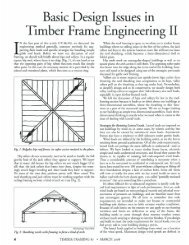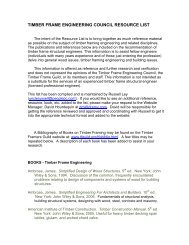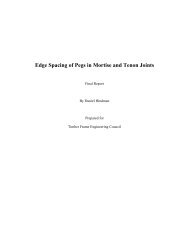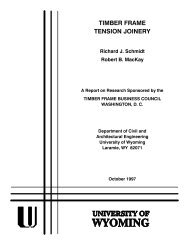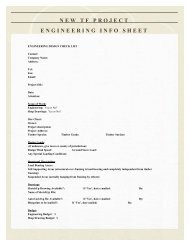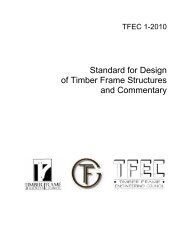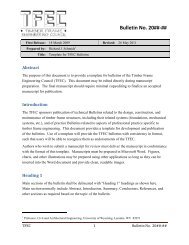Bulletin No. 20##-## - Timber Frame Engineering Council
Bulletin No. 20##-## - Timber Frame Engineering Council
Bulletin No. 20##-## - Timber Frame Engineering Council
You also want an ePaper? Increase the reach of your titles
YUMPU automatically turns print PDFs into web optimized ePapers that Google loves.
<strong>Bulletin</strong> <strong>No</strong>. <strong>20<strong>##</strong></strong>‐<strong>##</strong><br />
First Release: 18 March 2009 Revised: 04 June 2011<br />
Prepared by: Richard J. Schmidt 1<br />
Title: Template for TFEC <strong>Bulletin</strong>s<br />
Abstract<br />
The purpose of this document is to provide a template for bulletins of the <strong>Timber</strong> <strong>Frame</strong><br />
<strong>Engineering</strong> <strong>Council</strong> (TFEC). Authors may prepare their manuscript by editing this template.<br />
The final manuscript should require minimal copyediting for publication.<br />
Introduction<br />
The TFEC sponsors publication of technical bulletins on the design, construction, and<br />
maintenance of timber-frame structures, including related systems (foundations, mechanical<br />
systems, etc.), and of practice bulletins on aspects of professional practice specific to timberframe<br />
engineering. This document provides a template for development and publication of the<br />
bulletins. Use of this template will provide the TFEC bulletins with consistency in format, such<br />
that readers will be able to recognize them as endorsed by the TFEC.<br />
Authors who wish to submit a manuscript for review must deliver the manuscript in conformance<br />
with this template. Manuscripts must be prepared in Microsoft Word. Authors should complete<br />
the title block above with their names, the title of the bulletin, and the date of submission or<br />
revision. Include author affiliation and contact information in a footnote. The TFEC <strong>Bulletin</strong>s<br />
Editor will assign the <strong>Bulletin</strong> number.<br />
Figures, charts, and other illustrations may be prepared using other applications so long as they<br />
can be inserted into the Word document and provide clean, readable images. In some cases,<br />
authors may be required to submit original illustration files to ensure sufficiently high resolution<br />
for publication.<br />
1 Professor, Civil and Architectural <strong>Engineering</strong>, University of Wyoming, Laramie, WY 82071, schmidt@uwyo.edu<br />
TFEC 1 <strong>Bulletin</strong> <strong>No</strong>. 20XX‐XX
Heading 1<br />
Main sections of the bulletin shall be delineated with “Heading 1” headings as shown here.<br />
Main sections normally include Abstract, Introduction, Summary, Conclusions, References, and<br />
other sections as required by the topic of the bulletin.<br />
Heading 2<br />
Subsections under main sections shall be delineated with “Heading 2” headings as shown here.<br />
If subsections are used, they must be at least two in number within a main section.<br />
Heading 3<br />
Sub-subsections with subsections shall be delineated with “Heading 3” headings as shown here.<br />
When used, they too must be at least two in number within a subsection. However, they are to<br />
be used sparingly to avoid fragmentation of the text. Section delineations below level 3 are not<br />
permitted.<br />
Style<br />
Prepare the text in 12-point Times New Roman font. To the extent possible, avoid use of the<br />
passive voice. For spelling, punctuation, and capitalization, use Merriam Webster's Collegiate<br />
Dictionary. For words that do not appear in that dictionary, use Webster's Third International<br />
Dictionary. For engineering units, either US Customary units or SI units are acceptable. If one<br />
system of units is given preference, key values should also be presented in the other system of<br />
units. Avoid exact conversion of units for approximate numerical values. For instance, if a<br />
structure contains approximately 10,000 bf of timber, the appropriate SI quantity is 24 m 3 , not<br />
23.597 m 3 .<br />
Do not use the expression “and/or.” For example, when "A and/or B" is truly the case, write "A<br />
or B, or both." Also, do not use a slash (/) as a conjunction or a form of punctuation. Use “and,”<br />
“or,” commas, or semicolons as appropriate.<br />
In general, avoid the use of symbols in text. When stating dimensions, use "by" not x, for<br />
example, "10 by 5 in. (254 by 127 mm)." Show tolerances, for example, as 10 by 5 ± 2 in. (254<br />
by 127 ± 6 mm)." Do not use a hyphen or a dash for the word "to" (e.g. 2 to 4 inches thick)<br />
except in tables where needed to conserve space. Do not use ( ' ) or ( " ) for feet and inches in<br />
text, tables, or figures. For other information on style use Manual of Style, The University of<br />
Chicago Press.<br />
TFEC 2 <strong>Bulletin</strong> <strong>No</strong>. 20XX‐XX
Lists<br />
1. Numbered lists shall use Arabic numerals for the first level<br />
2. Numbered list continued<br />
a. Second level numbered lists shall use lowercase alpha labeling<br />
b. Second level numbered list continued<br />
• Bulleted lists shall use a solid bullet for the first level<br />
• Bulleted lists continued<br />
o Second level bullets shall be indented and use an open bullet<br />
o Second level bullet continued<br />
Figures and Tables<br />
Figures<br />
Figures, whether line drawings, photographs, or graphs, should be used to demonstrate some<br />
point or observation. Insert original, reproducible figures of professional quality directly in the<br />
manuscript in the position required. Figure elements and lettering must be legible at this size.<br />
Provide a short descriptive caption for each figure in 12 point Times New Roman font. Place the<br />
caption below the figure. Legends and annotations in the figures may be any font of appropriate<br />
size and clarity. Number figures consecutively and cite each figure in the text by figure number<br />
(e.g. "see Fig. 1") or for figures with multiple parts use Fig. 1(a), 1(b), etc.<br />
In charts and line drawings, use of color is encouraged, but recognize that often documents are<br />
duplicated in black and white. Hence, adjust line weight and style to provide additional<br />
distinguishing features. Figure 1 illustrates an appropriately formatted figure.<br />
TFEC 3 <strong>Bulletin</strong> <strong>No</strong>. 20XX‐XX
6000<br />
Load, lb<br />
5000<br />
4000<br />
3000<br />
2000<br />
MA-01<br />
MA-02<br />
MA-03<br />
MA-04<br />
MA-05<br />
MA-06<br />
MA-07<br />
MA-08<br />
MA-09<br />
radial<br />
loading<br />
tangential and<br />
diagonal loading<br />
1000<br />
0<br />
0 0.05 0.1 0.15 0.2 0.25<br />
Displacement, in<br />
Figure 1 – Dowel Bearing Behavior of Maple Pegs<br />
Tables<br />
Tables should be used to present data essential to the utility of the bulletin. Do not duplicate data<br />
in a table that is also illustrated in a figure or chart. The following points apply.<br />
• Number each table with an Arabic numeral and give it a title that is complete and<br />
descriptive. In column headings, first include the quantity being tabulated, then a<br />
comma, then the units, for example: "Tensile Strength, psi."<br />
• Do not use powers of 10 in the column heading, since it is not clear whether the numbers<br />
in the table have been or are to be multiplied by the power of ten. Instead, indicate the<br />
multiplication (for example, 1.45 x 10 6 ) in the first entry in the table, or use an expression<br />
such as "Young's Modulus, millions of psi" in the column heading.<br />
• For footnotes that appear in tables, use the style described in the Footnotes section.<br />
• Use horizontal rules under column headings. Use vertical rules only when the<br />
complexity of the table demands them for clarity. Use leaders (three periods) in any<br />
space that represents a blank entry.<br />
• Additional information can be included in a note that appears below the title.<br />
• When two (or more) separate systems of units are both listed in one table (for example,<br />
inch-pound and SI units), provide SI units in separate columns, in parentheses, or in<br />
brackets.<br />
• When the size of a table and limitations of space (on the printed page) make it impractical<br />
to expand the table to include SI unit equivalents, duplicate the table.<br />
TFEC 4 <strong>Bulletin</strong> <strong>No</strong>. 20XX‐XX
• When it is impractical to include two or more units of measurement in the column<br />
heading because of the size and the number of tables, include the pertinent conversion<br />
factors as footnotes under each table instead of attempting to include the actual converted<br />
values within the tables.<br />
• Do not allow a table to break between pages. If necessary, reformat it into smaller<br />
pieces, each of which fit on a single page.<br />
Tables 1(a) and 1(b) provide examples of appropriately formatted tables.<br />
Table 1(a) – Conversion Factors, US Customary Units to SI Units<br />
To convert from To Multiply by<br />
inches (in) millimeters (mm) 25.400<br />
inches (in) meters (m) 0.025400<br />
feet (ft) meters (m) 0.304800<br />
square feet (ft 2 ) square meters (m 2 ) 0.09290304<br />
cubic feet (ft 3 ) cubic meters (m 3 ) 0.028316847<br />
gallons (gal) liters (l) 3.785306<br />
miles/hour (mi/h) meters/second (m/s) 0.44704<br />
pounds (lb) newtons (N = kg·m/s 2 ) 4.4482217<br />
pounds/square foot (psf) pascals (Pa = N/m 2 ) 47.880<br />
kilopounds/square inch (ksi) megapascals (MPa = N/mm 2 ) 6.894757<br />
pounds/cubic foot (pcf) kilograms/cubic meter (kg/m3) 16.018463<br />
inch-pounds (in·lb) newton-meters (N·m) 0.11298483<br />
foot-pounds (ft·lb) netwon-meters (N·m) 1.3558179<br />
degrees (angle) radians (rad) 0.017453293<br />
degrees, Fahrenheit (°F) degrees, Celsius (°C) T °C = (T °F - 32°)/1.8<br />
TFEC 5 <strong>Bulletin</strong> <strong>No</strong>. 20XX‐XX
Table 1(b) – Conversion Factors, SI Units to US Customary Units<br />
To convert from To Multiply by<br />
millimeters (mm) inches (in) 0.039370079<br />
meters (m) inches (in) 39.370079<br />
meters (m) feet (ft) 3.2808399<br />
square meters (m 2 ) square feet (ft 2 ) 10.7639104<br />
cubic meters (m 3 ) cubic feet (ft 3 ) 35.3146667<br />
liters (l) gallons (gal) 0.26417944<br />
meters/second (m/s) miles/hour (mi/h) 2.23694<br />
newtons (N = kg·m/s 2 ) pounds (lb) 0.22480894<br />
pascals (Pa = N/m 2 ) pounds/square foot (psf) 0.020885547<br />
megapascals (MPa = N/mm 2 ) kilopounds/square inch (ksi) 0.145037944<br />
kilograms/cubic meter (kg/m3) pounds/cubic foot (pcf) 0.062427962<br />
newton-meters (N·m) inch-pounds (in·lb) 8.8507456<br />
netwon-meters (N·m) foot-pounds (ft·lb) 0.73756215<br />
radians (rad) degrees (angle) 57.2957795<br />
degrees, Celsius (°C) degrees, Fahrenheit (°F) T °F = 1.8T °C + 32°<br />
Footnotes<br />
The first footnote(s) in the text should identify the affiliation of the author(s). For all other<br />
footnotes appearing in the text, use superior numbers. The numbering scheme should pick up<br />
from where the author affiliation footnotes left off. For example, if on the first page there are 2<br />
author affiliation footnotes (1 and 2), then any footnotes on the following pages should pick up<br />
with number 3. Do not use footnotes in figure captions. Either cite a previous footnote or<br />
reference (for example, "see Footnote 3," or "taken from Ref [4]"), or write out the reference in<br />
the caption. For footnotes in tables, use superior lowercase, roman letters, beginning with “a”<br />
for each table. The footnotes should appear below the table.<br />
Equations<br />
Equations should be prepared with an equation editor and numbered consecutively throughout<br />
the text. Equations shall be roughly centered on the page with the equation number against the<br />
right page margin. All variables or parameters in an equation must be defined following their<br />
first use and shall be set in italic typeface in the text. An appropriate format for a numbered<br />
equation is:<br />
<br />
<br />
(1)<br />
TFEC 6 <strong>Bulletin</strong> <strong>No</strong>. 20XX‐XX
where:<br />
σ = stress, psi or Pa<br />
M = bending moment, lb-in or N-m<br />
c = distance from neutral axis to extreme fiber, in or m<br />
I = second moment of area (moment of inertia), in 4 or m 4<br />
Use parentheses liberally to clearly show the precise meaning of the expression. For example,<br />
does log a/b mean log (a/b) or (log a)/b Use the parentheses to clarify.<br />
References<br />
Cite references in sequential order by a number in brackets, such as [1]. List references in the<br />
References section in the order in which they are cited. Use the following formats for different<br />
types of references.<br />
Book Reference<br />
[1] AF&PA, 2005, National Design Specification for Wood Construction ASD/LRFD,<br />
American Forest & Paper Association, Washington, DC<br />
[2] Boresi, A. P. and Schmidt, R. J. 2003, Advanced Mechanics of Materials, 6E, John Wiley<br />
& Sons<br />
[3] FPS. 1999. Wood Handbook: Wood as an <strong>Engineering</strong> Material. Forest Products Society,<br />
Madison, WI<br />
Journal Article Reference<br />
[4] Murphy, J. F. 1986, Strength and Stiffness Reduction of Large <strong>No</strong>tched Beams, Journal of<br />
Structural <strong>Engineering</strong>, v 112, n 9, pp. 1989-2000, Sept<br />
[5] Wu E M. 1967. Application of fracture mechanics to anisotropic plates. Journal of Applied<br />
Mechanics, v 34 n 4, pp. 967-974<br />
Proceedings or Report Reference<br />
[6] Schmidt, R.J. and Scholl, G.F. Load Duration and Seasoning Effects on Mortise and Tenon<br />
Joints, University of Wyoming, Department of Civil and Architectural <strong>Engineering</strong>,<br />
Laramie, August 2000<br />
[7] Gerhardt T D. 1984. Strength and stiffness analysis of notched, green oak pallet stringers.<br />
FPL Research Paper 452. US Forest Service. Madison WI<br />
TFEC 7 <strong>Bulletin</strong> <strong>No</strong>. 20XX‐XX


